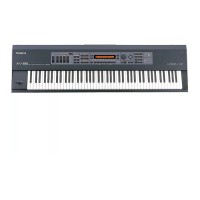Roland XV-88 - Sibelius Sound Set User Manual | 15
5. Working with Sounds
5.1 Articulations/Techniques
ere are three primary ways of changing articulations and playing techniques in your
score, articulation markings, text instructions, and lines. Symbols may also be used,
but are not as common. rough the sound set these instructions are interpreted and
the appropriate MIDI data is generated, whether that be a keyswitch, continuous con-
troller change, or other similar message, invisibly, and automatically.
Each of these methods creates sound changes in slightly dierent ways, and while stan-
dard notation practice will generally dictate which method is used in a given context,
understanding how each one works together and separately is important.
Articulation Markings
Includes such markings as staccato, staccatissimo, marcato, tremolo, etc. Articulation
markings are in eect for the duration of the note to which they are attached, after
which the sound is reset or changes to the next indicated sound. Using articulation
markings is perhaps the most obvious way of changing sounds in a score, but may not
be the most ecient in all contexts.
Articulation marks generally change sounds by way of a sound ID change, with a fall-
back behavior that will simulate the technique in the event a matching sound ID is not
found. For example, if a staccato mark is written but a staccato sample is not available,
Sibelius will shorten the note duration to mimic the staccato eect.
e fallback behavior, while useful, is not entirely reliable with dierent issues ap-
pearing in dierent versions of Sibelius. e two most common issues, which extend
to sta lines as well, include fallback behavior overriding a sound ID change and the
fallback behavior being executed in addition to the sound ID change (unmeasured
tremolo and slurs, respectively, are examples). In practice this will have little eect on
your work since the sound set and House Styles are built to accommodate these incon-
sistencies, but it’s something to be aware of.
Because articulation markings are automatically reset/changed at the end of the note,
repeated notes using the same articulation (e.g., staccato) can suer from a pulsing
and ill-dened eect, especially at faster tempi, as superuous MIDI data is generated
(a reset and retrigger for each individual note as opposed to once per passage). Our
Knowledge Base article Fast Staccato Passages Muddy sheds some light on this issue.

